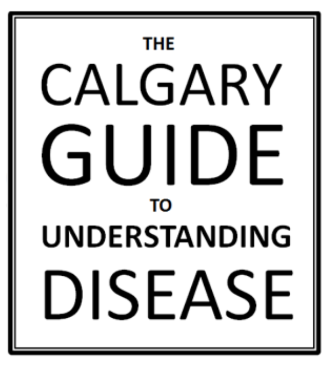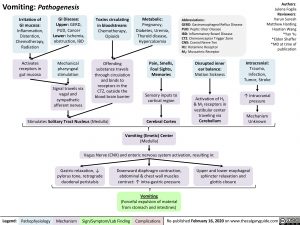Vomiting: Pathogenesis
Authors: Julena Foglia Reviewers: Varun Suresh Matthew Harding Haotian Wang *Yan Yu *Eldon Shaffer *MD at time of publication
Intracranial:
Trauma, Infection, Tumor, Stroke
↑ Intracranial pressure
Mechanism Unknown
Irritation of GI mucosa: Inflammation, Distention, Chemotherapy, Radiation
Activates receptors in gut mucosa
GI Disease: Upper: GERD, PUD, Cancer Lower: Ischemia, obstruction, IBD
Mechanical pharyngeal stimulation
Signal travels via vagal and sympathetic afferent nerves
Metabolic:
Pregnancy, Diabetes, Uremia,
Thyroid disease, Hypercalcemia
Pain, Smells, Foul Sights, Memories
Sensory inputs to cortical region
Cerebral Cortex
Vomiting (Emetic) Center
Toxins circulating in bloodstream: Chemotherapy, Opioids
Offending substance travels through circulation and binds to receptors in the CTZ, outside the blood brain barrier
Abbreviations:
GERD: Gastroesophageal Reflux Disease PUD: Peptic Ulcer Disease
IBD: Inflammatory Bowel Disease
CTZ: Chemoreceptor Trigger Zone
CNX: Cranial Nerve Ten
H1: Histamine Receptor
M1: Muscarinic Receptor
Disrupted inner ear balance: Motion Sickness
Activation of H1 & M1 receptors in vestibular center traveling via Cerebellum
Stimulates Solitary Tract Nucleus (Medulla)
(Medulla)
Vagus Nerve (CNX) and enteric nervous system activation, resulting in:
Gastric relaxation, ↓ pylorus tone, retrograde duodenal peristalsis
Downward diaphragm contraction, abdominal & chest wall muscles contract: ↑ intra-gastric pressure
Vomiting
(Forceful expulsion of material from stomach and intestines)
Upper and lower esophageal sphincter relaxation and glottis closure
Legend:
Pathophysiology
Mechanism
Sign/Symptom/Lab Finding
Complications
Re-published February 16, 2020 on www.thecalgaryguide.com

